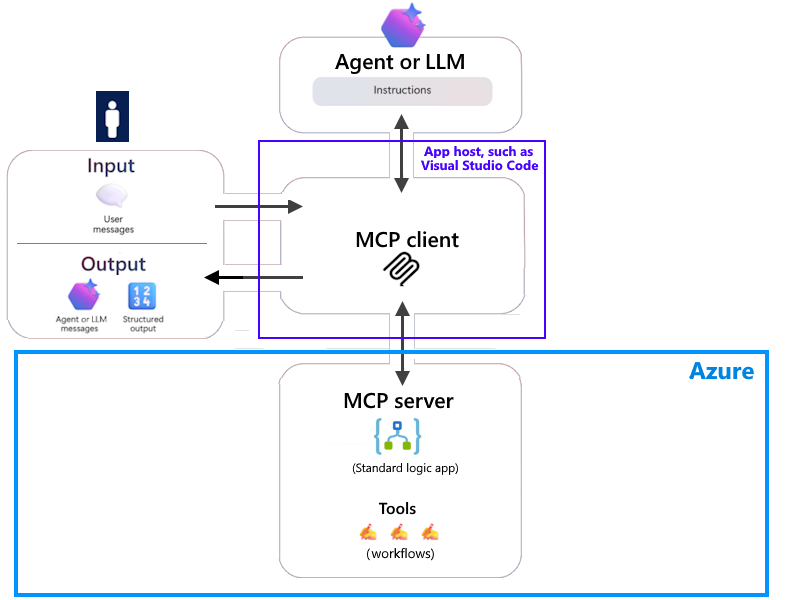Integrating AI agents and large language models (LLMs) into enterprise systems can be challenging without the right infrastructure. Azure Logic Apps (Standard) introduces remote Model Context Protocol (MCP) servers as a preview feature, empowering organizations to connect AI tools with business workflows seamlessly. This innovation enables AI-powered automation across existing business logic, saving development time and enhancing flexibility.
What Is the MCP Server Model?
MCP is an open standard that enables AI agents and LLMs to interact securely and systematically with enterprise workflows. By configuring a Standard logic app as a remote MCP server, organizations can expose workflows as callable tools for AI agents.
These agents, even when running in external environments like Visual Studio Code, can remotely trigger processes, access databases, and execute logic without direct integration or duplicated effort.
- Reusability: Repurpose existing connectors and workflows for AI integration.
- Flexibility: Choose from 1,400+ connectors to reach cloud or on-premises resources.
- Security: Implement enterprise-grade authentication with OAuth 2.0 and Easy Auth.
- Monitoring: Use Application Insights or Log Analytics for full traceability.
- Deployment Options: Host MCP servers in the cloud, on private endpoints, or within virtual networks.
This architecture also supports Streamable HTTP and Server-Sent Events (SSE), broadening integration scenarios.
Prerequisites for MCP Server Setup
Before setting up an MCP server, ensure you have:
- An Azure subscription and a Standard logic app with active workflows.
- Workflows triggered by HTTP requests and featuring a Response action.
- An appropriate Workflow Service Plan or App Service Environment v3.
- App registration in Microsoft Entra ID for Easy Auth authentication.
- Visual Studio Code (v1.102+) and the GitHub Copilot extension for testing.
- Optional: Virtual network integration and host.json adjustments for SSE support.
Best Practices for Workflow Design
To optimize AI interaction, follow these workflow tooling tips:
- Trigger Descriptions: Clearly state the workflow’s purpose within the Request trigger, this helps agents select the right tool.
- Parameter Metadata: Use descriptive names, data types, and formats in the Request Body JSON Schema, and identify required parameters.
- Error Handling: Implement explicit error responses and use the
runAfterproperty for detailed diagnostics.

Configuring Secure Authentication
Security is paramount in enterprise AI integration. Follow these steps:
- Register an application in Microsoft Entra ID and configure necessary API scopes like user_impersonation.
- Set up Easy Auth on your logic app, specifying Microsoft as the identity provider and entering registration details.
- Customize access controls to restrict usage to specific users, apps, or tenants.
Enabling MCP Server Endpoints
To activate MCP features in your logic app, update your host.json file:
- Add
extensions.workflow.McpServerEndpoints.enablewith a value oftrue.- Optionally, adjust authentication or metadata settings as needed.
- If leveraging SSE, enable cross-worker communication by setting
Runtime.Backend.EdgeWorkflowRuntimeTriggerListener.AllowCrossWorkerCommunicationtotrue.
Testing and Using the MCP Server
Once configured, test your MCP server by:
- Retrieving the server URL via the Azure management API.
- Adding the MCP server in Visual Studio Code using the Command Palette, providing the URL and a friendly name.
- Storing configuration globally or per project workspace.
- Starting the server and authenticating when prompted.
- Using GitHub Copilot’s chat interface to interact with your logic app-powered tools for LLM automation.
Key Takeaways
Turning your Azure Logic App into an MCP server opens new pathways for AI-driven automation in the enterprise. This approach enhances reusability, enforces governance, and accelerates AI adoption all while leveraging existing investments in Azure infrastructure.
For more information, see the following articles:
- What is an AI Agent?
- About LLMs
- MCP server concepts
- MCP client concepts
- Introduction - Get started with the Model Context Protocol (MCP)

Azure Logic Apps as MCP Servers Supercharge Enterprise AI Integration